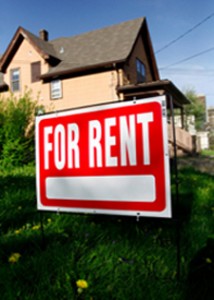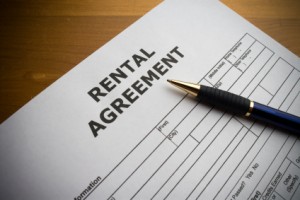Posted by Teresa on March 31, 2011 under Landlord Tips | 
 So, you’ve landed a new tenant for that vacant rental you’ve been showing. He paid the deposit, and you’re in the tenant background check phase of your due diligence process. Now you can take down the flier you posted at the local coffee shop, stop showing the unit and cancel your ads, right?
So, you’ve landed a new tenant for that vacant rental you’ve been showing. He paid the deposit, and you’re in the tenant background check phase of your due diligence process. Now you can take down the flier you posted at the local coffee shop, stop showing the unit and cancel your ads, right?
Sure, if you’re betting that the deposit check won’t bounce, the tenant credit report will come back at an acceptable level and the tenant’s references will all check out. But smart landlords know that anything can happen between the lease application and the lease signing. Tenants change their minds every day. References don’t check out. And credit scores are more iffy than ever these days. Maybe showing the rental property to additional prospective tenants is the better way to go.
Every landlord should have a back-up plan, just in case the shiny new tenant doesn’t prove to be 100% reliable. Besides, unless and until you have a signed lease, you don’t really have a new tenant.
There are several advantages to continue marketing a pending rental property:
- You’ll have prospects for your additional rental properties.
- Murphy’s Law says that as soon as you stop marketing one rental property, another one will become vacant!
- You can refer your prospects to other landlords in your network.
- A waiting list can move a hesitant tenant from “just looking” to “where do I sign?”
- You might find a better-qualified tenant than the one you’re working with.
Some landlords would say that “never” is when they stop marketing their rental properties. As in any profession, being proactive is better than being reactive in the rental property business. No matter how good a prospective tenant looks, make sure you have a back-up plan. Keep marketing and showing your rental unit and gather names for a waiting list—just in case the deal falls through.
Posted by Teresa on March 26, 2011 under Landlord Tips | 
 Pest control in rental properties is a continual issue in some areas—and not such a big deal in others. Unfortunately, mice (and rats) live almost everywhere, while scorpions, cockroaches and certain other multi-legged intruders are more bothersome to landlords in warmer climates.
Pest control in rental properties is a continual issue in some areas—and not such a big deal in others. Unfortunately, mice (and rats) live almost everywhere, while scorpions, cockroaches and certain other multi-legged intruders are more bothersome to landlords in warmer climates.
In years past, landlords often kept bugs under control with regular spraying of chemical pesticides. A greater awareness of the toxicity associated with these pest control treatments is prompting many rental property owners to revisit their standard control methods in favor of healthier alternatives for their tenants.
Fortunately, landlords now have more options when it comes to controlling cockroaches, ants, mice, rats, fleas, centipedes and even bed bugs in their rental properties. Cedar and other essential oils, along with enzymes are safe to use around pets, kids and food, and are used by increasing numbers of professional pest control companies.
One example is the use of microscopic animals called nematodes to control termites. Nematodes are added to water and then poured into termite nests, where they kill either the queen or enough worker termites that the queen eventually starves. Check with your pest control company to see if they offer natural and non-toxic alternatives.
Don’t forget that you can take control of certain pest problems without chemicals on your own. Peppermint oil is said to deter rats from entering an area, but it requires regular application. Keeping garbage secure and sealed tightly is another effective rat deterrent—so instruct tenants on proper garbage procedures. It’s never a good idea to put rat poison out where any other animal or child could ingest it!
Boric acid, which is very low in toxicity to people and pets, is often used to control carpenter ants and cockroaches. However, it is not always advised for use around food, where cockroaches tend to be. The best cockroach prevention is cleanliness. Frequent vacuuming, eliminating standing water and leaks, and keeping grocery bags and boxes outside are all methods that can help keep cockroaches under control.
If you’re trying to improve your green living score, take a look at one of the most toxic areas of managing rental properties: pest control. A little extra effort can keep your tenants safer and help them live healthier lives.
Posted by Teresa on March 22, 2011 under Landlord Paperwork and Forms | 
 Harry the landlord notices a broken window in Unit A during a routine maintenance visit to Unit B. He knocks on Unit A’s door to arrange a repair and is greeted by someone he’s never seen, much less approved to live there. The man asks Harry what he wants; Harry explains that he is the building owner. “Oh. I’m visiting,” the man replies.
Harry the landlord notices a broken window in Unit A during a routine maintenance visit to Unit B. He knocks on Unit A’s door to arrange a repair and is greeted by someone he’s never seen, much less approved to live there. The man asks Harry what he wants; Harry explains that he is the building owner. “Oh. I’m visiting,” the man replies.
Later, Harry asks the tenant in Unit B if she has seen the man in Unit A. “You mean Scott?” she answers. “He’s been there for a couple of months.”
There is a fine line between a visitor and an unauthorized resident. Explaining the difference to your tenants can be tough—but it’s something a landlord must do to avoid the risk and potential problems that come when unscreened and unauthorized tenants live in your rental property.
Luckily, making sure you’re legally covered is easy. Just make sure your lease specifies what tenants can and cannot do when it comes to guests.
Harry’s lease does prohibit unauthorized residents. When he brings this to Unit A’s attentions, the tenant replies that her friend is not a resident—he’s just visiting.
Harry reviewed his rental agreement and realized it didn’t specify any time limit for guests or visitors. He revised it to read:
“Persons other than those specifically listed on the Rental Agreement shall be strictly prohibited from staying in the rental unit for more than 7 consecutive days, or a total of 20 days in any 12-month period. Tenant shall notify Owner in writing any time the Tenant expects any guest will be staying in excess of the time limits herein. Additional residents will be subject to full screening procedures, additional rent and security deposit. Unauthorized residents are a violation of this Rental Agreement and grounds for termination of the Rental Agreement.”
Harry was still within his rights to notify the tenant in Unit A that her unauthorized guest had overstayed his welcome and that he would need to move or she would be in violation of her lease. Luckily, she didn’t push the issue and the visitor was soon gone.
Don’t expose your tenants or your business to the risks of unscreened residents. Require your tenants to clear it with you before allowing anyone to move in. Require the new roommate to fill out a lease application and undergo tenant screening and a background check before they unpack their first box of belongings!
Posted by Teresa on March 21, 2011 under Landlord Tips | 
 One of the biggest challenges for landlords is maintaining their rental properties. Failure to do so can lead to further damage, unhappy tenants and lower property values.
One of the biggest challenges for landlords is maintaining their rental properties. Failure to do so can lead to further damage, unhappy tenants and lower property values.
Some landlords prefer to do all their own maintenance; others are not capable or simply don’t have the time to perform maintenance. Still others make the attempt to do it themselves, only to realize they’re in over their heads.
If you’re thinking about hiring a contractor or handyman service to take care of routine maintenance and emergency repairs on your rental properties, here are a few tips.
- Do you need occasional help or a full-time maintenance person? Would you rather hire expert plumbers, electricians and carpenters each time you need specialty work? Knowing what you need is the first step. A long-term contract for routine maintenance plus regular repairs might be more economical than calling an expensive contractor for a smaller job. And don’t forget that availability is sometimes a problem with busy general contractors. A regular maintenance contract means priority when you have an emergency.
- Once you determine your rental property maintenance needs, ask for referrals.When working with an contractor, it’s sometimes difficult to know whether you’re getting a good deal and getting good work—or being ripped off. Your local builder and remodeler association is the perfect place to start your research. Also ask other rental property owners in your network. You might hear an earful about whom to avoid—and who is most trustworthy.
- Once you’ve narrowed your choices down, it’s a good idea to conduct a “job interview” with each one. Even though they will likely be a subcontractor, and not an employee, you’ll still need to be sure that there is a good rapport and mutual respect between you. If you’ve found the right person, you might be in partnership for a long time—and you want to make sure you can get along.
- Conducting due diligence on your potential handyman is another important to-do item. Check with your state licensing board to ensure your prospective contractor holds proper business and contracting licenses, and is bonded and insured. Individuals without proper licenses are best avoided. And don’t rule out conducting a background check. Anyone with access to your rental property puts you and your tenants at risk. Mitigate that risk by knowing exactly whom you are hiring. Be sure to ask for and check references before you make your final decision.
Posted by Teresa on March 17, 2011 under Landlord and Tenant FAQs | 
 Most landlords and property managers know that whether or not pets are allowed in their rental properties, exceptions must be made to accommodate companion and service animals for the disabled, under the Americans with Disabilities Act (ADA). But what functions as a service animal for a tenant might not look like a service animal to you.
Most landlords and property managers know that whether or not pets are allowed in their rental properties, exceptions must be made to accommodate companion and service animals for the disabled, under the Americans with Disabilities Act (ADA). But what functions as a service animal for a tenant might not look like a service animal to you.
A landlord might wonder how a bird or a snake could be used as a service animal. After all, it’s not as though they help the tenant cross the street.
Rental property owners and managers must remember that not all disabilities can be seen. For example, people who suffer seizures sometimes use boa constrictors to warn them of a coming seizure. The snakes gently squeeze their owners when they feel a seizure coming on, so the person can take medication or remove him or herself from a stressful setting.
Cats and ferrets are sometimes used by individuals who experience anxiety. The animals might serve to calm them down when during air or water travel. And a parakeet can help a person with severe depression by acting as the focus of the person’s care and attention. In this way, the bird improves the person’s daily functioning—which is the definition of a companion animal.
The ADA rule covering companion animals requires tenants to obtain certification by a medical professional that the animal is necessary to relieve the disability. If a tenant has such an order, then the rental property owner or manager must make reasonable accommodations for the animal. And remember, service animals are not pets.
The U.S. Department of Justice is currently trying to define service animals. Last year, it received thousands of comments when it announced plans to exclude from the definition wild animals and service animals whose sole function is to provide emotional support, comfort, therapy, and companionship, and to promote emotional well-being. We will keep you posted on what the DOJ decides!
Pre-screen all tenants as part of your standard application process. Background and credit checks will help ensure you rent to qualified tenants. For more landlord resources, including forms and information on tenant screening, turn to E-Renter.com.
Posted by Teresa on March 11, 2011 under Tenant Credit Checks | 
 What should a landlord do when a potential tenant states they have had their credit report pulled recently and therefore, there’s no need to run another credit report for their lease application? Should they accept the applicant’s report and save the time and trouble?
What should a landlord do when a potential tenant states they have had their credit report pulled recently and therefore, there’s no need to run another credit report for their lease application? Should they accept the applicant’s report and save the time and trouble?
In a word: no. Some tenants might be trying to save money and might not see the need for another credit report. Or, they may want you to know up front that their credit score is low; in this case you can make a decision to continue with your own report or reject their lease application.
And then there are those who fabricate their own credit reports, which happens every day to landlords and others who aren’t as cautious as they should be. Fake credit reports are widely available, so don’t make the mistake of accepting any credit report other than one from a trusted service provider.
Smart landlords don’t run their rental property business on guesswork. To really know who you’re renting to, always reinforce your policy that a credit and background check will be conducted on every tenant applicant.
If, after hearing you won’t accept their credit report, the potential tenant is no longer interested in your rental property, you might have dodged a bullet.
Of course, there are exceptions to every rule! In some states, landlords must accept a potential tenant’s credit report if it is no older than 30 days. Other states have legislation that a credit bureau must forward an existing credit report whenever the tenant applies for a lease within 30 days. These laws are designed to prevent tenants from incurring high fees from repeated applications.
Landlords have the right to protect their business interests by leasing to qualified tenants. Make sure yours are qualified by conducting a thorough credit and background check on each one–even if they have one in their pocket for you!
Posted by Teresa on March 9, 2011 under Landlord Paperwork and Forms, Landlord Tips | 
 Just when a landlord thinks that business is quiet—or even under control—something unexpected happens. Like you receive notice that a tenant is moving out. If it’s a great tenant, you might feel a pang of regret; if not, perhaps you’ll hear a sigh of relief.
Just when a landlord thinks that business is quiet—or even under control—something unexpected happens. Like you receive notice that a tenant is moving out. If it’s a great tenant, you might feel a pang of regret; if not, perhaps you’ll hear a sigh of relief.
Either way, the minute you receive that notice is when the tenant transition begins.
- Most leases require a 30- or 60-day notice when either party is intending to not renew. It’s a good idea to regularly review your lease expiration dates so you’re not surprised by a tenant’s notice. If you see one that will soon expire, go ahead and check in with your tenants to see if they’re planning on staying or leaving. The more time you have to prepare, the better.
- Of course, you’ll want to begin the search for a qualified new tenant immediately. Start by advertising in all your usual places, and put signs up in the neighborhood and on the property.
- Let the vacating tenant know you’ll be showing the rental unit to prospective new tenants. Try to be respectful of their time and privacy; but do insist on your rights to show the unit if they prove to be difficult about scheduling.
- You might want to make an appointment with your tenant to take a quick look through the unit to determine any work that needs to be done after they move out. Be sure to explain that this visit is NOT a move-out inspection, which will be performed after the unit is empty. This is just a helpful way to plan any painting, repairs and upgrades that will need to be completed before the next tenant moves in.
- Schedule the move-out inspection for moving day. Let your tenant know they’ll need time to move their belongings and clean the unit before you arrive. Remind them to pull out their move-in/move-out checklist to see what items you’ll be inspecting. Bring your copy of this document with you when you inspect.
- Once the rental unit is empty, you should be ready to immediately begin painting, repairs, replacing fixtures or floor tiles, and any pest treatment or carpet cleaning that is needed.
- Continue to show the property while repairs and painting are taking place. Remind prospective tenants that the unit will be completely ready for move-in day. Have photos available to show.
Posted by Teresa on March 4, 2011 under Landlord Tips | 
 Sometimes landlords simply can’t fill a vacancy, despite market data that shows vacancies are low and would-be renters are finding it hard to find a place to live. Have you ever had a vacancy that should have been filled, but after many showings you have no bites?
Sometimes landlords simply can’t fill a vacancy, despite market data that shows vacancies are low and would-be renters are finding it hard to find a place to live. Have you ever had a vacancy that should have been filled, but after many showings you have no bites?
Consider these reasons you’re having trouble filling a vacant rental:
Price: Have you checked the rents in your area lately? Perhaps yours is just too high for the number of bedrooms, bathrooms and amenities your rental property offers. Do your homework and adjust the rent if you have to. Try rentometer.com to compare your rent to others in your city—and even in your neighborhood.
Location: Is your rental property too far from public transportation and shopping? While there’s not much you can do to make a poor location better, you can promote other advantages of the location. Is there a park or walking and biking trail nearby? Is it a walkable neighborhood? What about a neighborhood market? Think about other factors you can educate potential tenants about. What would make you want to live there? And don’t expect the location to sell itself—that’s your job!
Utilities: Most tenants want cable and high-speed internet. Wireless is even better. If you don’t offer the latest and greatest technology, you could be losing tenants for that reason alone. Inquire with your cable and internet service providers to see what they can do to upgrade your property and bring it into the 21st century!
Looks: Take a hard view at how your rental looks from the outside and the inside.
- Does it look inviting?
- Are there dead shrubs outside and broken window blinds inside?
- Does it need a paint job?
- Are carpets worn out?
- Do the fixtures and lighting need an upgrade?
- If it’s been awhile since you spruced up the place, it could be costing you money as potential tenants turn it down.
Finally, when you’re showing the unit, ask potential tenants if they can picture themselves living there. It doesn’t hurt to find out what they’re thinking, and you’ll learn very valuable information. If they offer an objection, find a way to overcome it—and fill that vacancy!
Pre-screen all tenants as part of your standard application process. Background and credit checks will help ensure you rent to qualified tenants. For more landlord resources, including forms and information on tenant screening, turn to E-Renter.com.
Posted by Teresa on March 1, 2011 under Landlord Tips | 
 Taking the plunge into rental property investment? Here are some tips to consider when searching for your first property.
Taking the plunge into rental property investment? Here are some tips to consider when searching for your first property.
- Know how long you’ll own it. If you’re in for five years, you don’t want to invest a ton of cash into big-ticket items, like a new HVAC system, roof or major structural repairs. On the other hand, if you plan to own the property for 20 years, you’ll most likely need to make some major improvements. But that’s okay, since you’ll be holding a longer-term investment and will have a chance to recoup the costs.
- Know the type of investment that fits you best. Is it apartment buildings or single-family homes? Do you want to be a long-term landlord, or buy and resell quickly?
- Location is crucial. Just like when you open a business, you want the best location possible. Well, your investment property is a business, so the same thinking applies. A large pool of potential renters, such as a college town or higher-population area, is the first indicator of a great location. Next, look for nearby public transportation, recreational opportunities, shopping areas and a low crime rate.
- Leave emotion out of the equation. Most investors don’t fall in love with rental properties. The only thing that should matter is how the numbers shake out.
- Plan, plan, plan. Get your finances in shape long before you’re ready to buy. Meet with your financial advisor, lawyer and insurance agent to carefully scrutinize the assets you can devote to this investment, as well as the protection from risk and liability you’ll need.
- Don’t pay too much. Negotiate for the best price you can get up front. If you overpay for an investment property, you’ll never recoup your money. Again, the numbers are the only thing that matters when buying investment property. If they don’t work on a particular property, walk away.
- Learn your market. How does an investor know when the numbers make sense? It depends on your market. There are formulas you can try, such as paying no more than six to eight times the first year’s rents. Another formula we’ve seen is to pay no more than 70% of the price the property would be worth after making all the necessary repairs and upgrades after purchasing it.
- Make sure rents will cover your out-of-pocket expenses. Mortgage, insurance, taxes, maintenance repairs and a percentage to cover vacancies must be paid out of the rental income so that the property at least breaks even.
Disclaimer:
This site is intended to provide useful information. It is not intended to provide professional financial or legal advice and cannot substitute for professional advice. Seek independent professional advice from a competent licensed professional before acting upon any information contained herein.
 So, you’ve landed a new tenant for that vacant rental you’ve been showing. He paid the deposit, and you’re in the tenant background check phase of your due diligence process. Now you can take down the flier you posted at the local coffee shop, stop showing the unit and cancel your ads, right?
So, you’ve landed a new tenant for that vacant rental you’ve been showing. He paid the deposit, and you’re in the tenant background check phase of your due diligence process. Now you can take down the flier you posted at the local coffee shop, stop showing the unit and cancel your ads, right?






